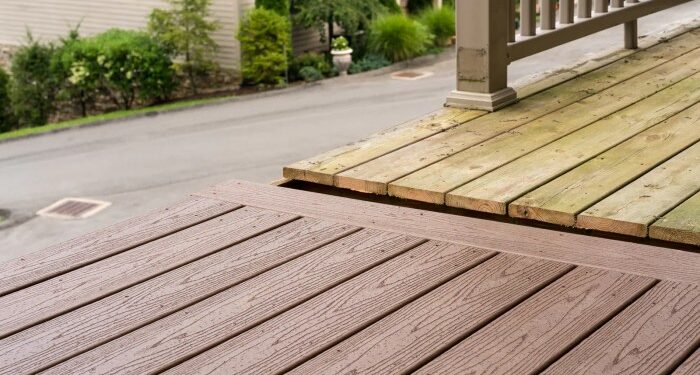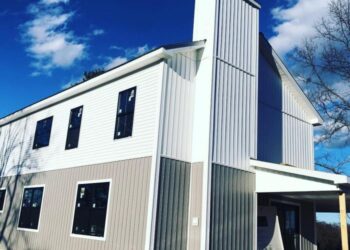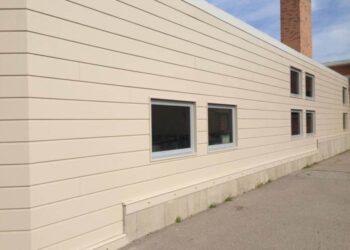Exploring the world of decking materials, this article delves into the differences between composite and wood decking. From composition to installation, we will uncover the pros and cons of each option, helping you make an informed decision for your outdoor space.
Composite Decking
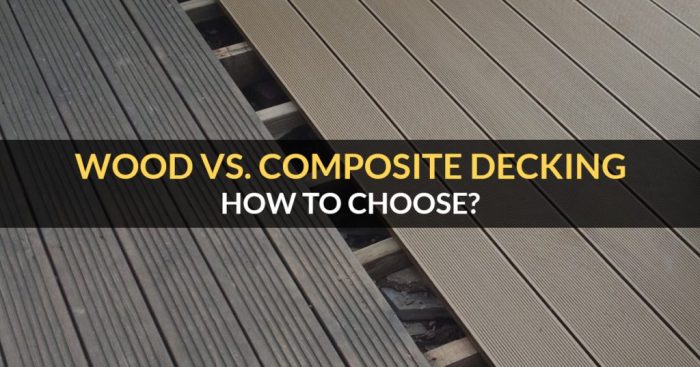
Composite decking is made from a combination of wood fibers, plastic, and binding agents. This mixture results in a durable and low-maintenance material that mimics the look of real wood.
Composition of Composite Decking Materials
Composite decking materials typically consist of a blend of recycled wood fibers, plastic, and bonding agents. This combination creates a strong, weather-resistant material that requires minimal upkeep.
Benefits of Using Composite Decking Over Wood
- Composite decking is highly durable and resistant to rot, mold, and pests.
- It does not require staining or sealing, saving time and money on maintenance.
- Composite decking is available in a wide range of colors and styles to suit any aesthetic preference.
- It is environmentally friendly, as it is often made from recycled materials.
Comparing Durability of Composite Decking to Wood Decking
Composite decking is known for its exceptional durability, as it is resistant to warping, cracking, and fading that can occur with traditional wood decking. This makes it a long-lasting investment for outdoor spaces.
Maintenance Requirements of Composite Decking
- Composite decking requires minimal maintenance, usually only needing occasional cleaning with soap and water.
- Unlike wood decking, composite decking does not need to be stained or sealed to maintain its appearance.
- Regular inspections for mold or mildew growth are recommended to ensure the longevity of the material.
Wood Decking
Wood decking is a popular choice for outdoor spaces, offering a natural and classic look to any deck. There are several types of wood commonly used for decking, each with its own characteristics and benefits.
Types of Wood for Decking
- Cedar: Known for its natural resistance to insects and decay, cedar is a popular choice for decking.
- Pressure-treated Pine: Affordable and readily available, pressure-treated pine is treated to resist rot and insects.
- Redwood: Redwood is a durable and naturally resistant wood that offers a beautiful finish to any deck.
- Ipe: Ipe is a hardwood known for its durability and resistance to rot, making it a long-lasting choice for decking.
Natural Characteristics of Wood Decking
Wood decking materials offer a natural beauty and warmth that is hard to replicate with composite materials. However, wood decking is prone to issues such as fading, splintering, and warping over time. Regular maintenance, such as staining and sealing, is often required to keep wood decking looking its best.
Environmental Impact of Wood Decking
While wood is a renewable resource, the harvesting of wood for decking can have environmental implications. Deforestation, habitat destruction, and chemical treatments used in pressure-treated wood are some of the concerns associated with wood decking. Choosing sustainably sourced wood or reclaimed wood can help reduce the environmental impact of using wood decking.
Cost Comparison of Wood Decking vs. Composite Decking
Wood decking is generally more affordable upfront compared to composite decking. However, the long-term costs of maintenance and upkeep for wood decking can add up over time. Composite decking, on the other hand, requires minimal maintenance and is more durable, which can result in cost savings in the long run.
Installation Process
When it comes to installing decking, whether it's composite or wood, the process can make a significant difference in the overall outcome. Let's take a closer look at the installation process for both types of decking materials to see how they compare in terms of ease of installation.
Composite Decking Installation
Installing composite decking is generally considered to be easier and more straightforward compared to wood decking. Here is a step-by-step guide on how to install composite decking:
- Prepare the deck area by ensuring the surface is clean, level, and free of debris.
- Begin by laying down the composite boards, ensuring they are properly spaced and aligned.
- Secure the boards using composite decking screws or clips, following the manufacturer's guidelines.
- Trim any excess material and add finishing touches as needed.
Wood Decking Installation
Installing wood decking can be a bit more labor-intensive compared to composite decking. Here is a step-by-step guide on how to install wood decking:
- Prepare the deck area by ensuring the surface is clean, level, and treated for protection against moisture and pests.
- Start by laying down the wood boards, ensuring they are properly spaced and aligned.
- Secure the boards using decking nails or screws, making sure they are driven in at the correct angle and depth.
- Apply a protective finish to the wood to prevent rot, decay, and fading over time.
Overall, the ease of installation between composite and wood decking can vary based on the individual's experience and familiarity with the materials. However, composite decking is generally considered to be more user-friendly and less time-consuming to install compared to wood decking.
Maintenance and Care
When it comes to maintaining and caring for your decking, whether composite or wood, proper upkeep is essential to prolong its lifespan and keep it looking its best for years to come.
Maintenance for Composite Decking
Composite decking is known for being low-maintenance compared to wood decking. Here are some key points to consider:
- Regular cleaning with soap and water is usually sufficient to keep composite decking looking good.
- Avoid using harsh chemicals or pressure washers, as they can damage the surface of the decking.
- Inspect the boards for any signs of mold or mildew and address it promptly to prevent further damage.
- Periodically check for loose screws or fasteners and tighten them as needed to prevent any safety hazards.
Maintenance for Wood Decking
Wood decking requires more maintenance compared to composite decking. Here are some tips for keeping your wood decking in top condition:
- Regularly seal or stain the wood to protect it from the elements and prevent rot or decay.
- Clean the decking regularly to remove debris and prevent mold or mildew growth.
- Inspect the boards for any signs of rot or insect damage and replace any damaged boards promptly.
- Keep an eye on the structural integrity of the deck, including the support beams, to ensure safety and longevity.
Long-term Maintenance Costs Comparison
When comparing the long-term maintenance costs between composite and wood decking, it is important to consider the following:
- Composite decking typically requires less maintenance over time, saving you money on cleaning supplies, sealants, and stains.
- Wood decking may require more frequent maintenance and replacement of damaged boards, which can add up in terms of time and cost.
- While the upfront cost of composite decking may be higher, the lower maintenance requirements can result in cost savings in the long run.
- Wood decking, on the other hand, may require more frequent refinishing and repairs, increasing the overall maintenance costs over time.
Ending Remarks
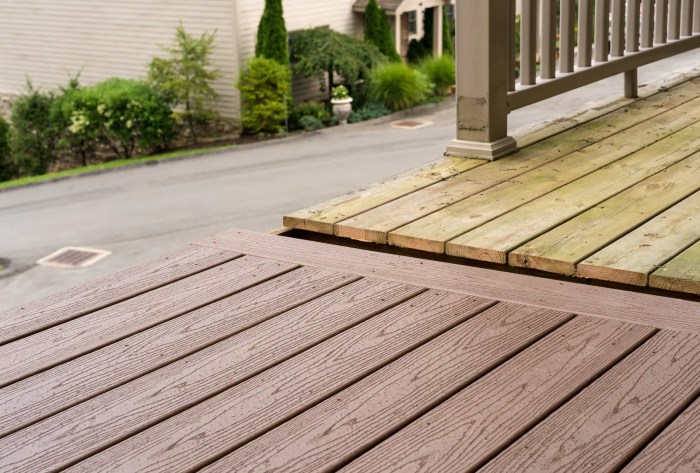
In conclusion, whether you opt for the low maintenance of composite decking or the classic appeal of wood decking, both options have their unique advantages. Consider your priorities and preferences to choose the decking material that best suits your needs and lifestyle.
General Inquiries
Is composite decking more expensive than wood decking?
Composite decking tends to have a higher upfront cost than wood decking, but it requires less maintenance over time, potentially balancing out the overall expenses.
Can wood decking be as durable as composite decking?
While certain types of wood decking can be durable, composite decking generally offers better resistance to elements like moisture, rot, and pests.
How long does wood decking typically last compared to composite decking?
Wood decking can last around 10-30 years with proper maintenance, while composite decking can have a lifespan of 25-30 years or more.

